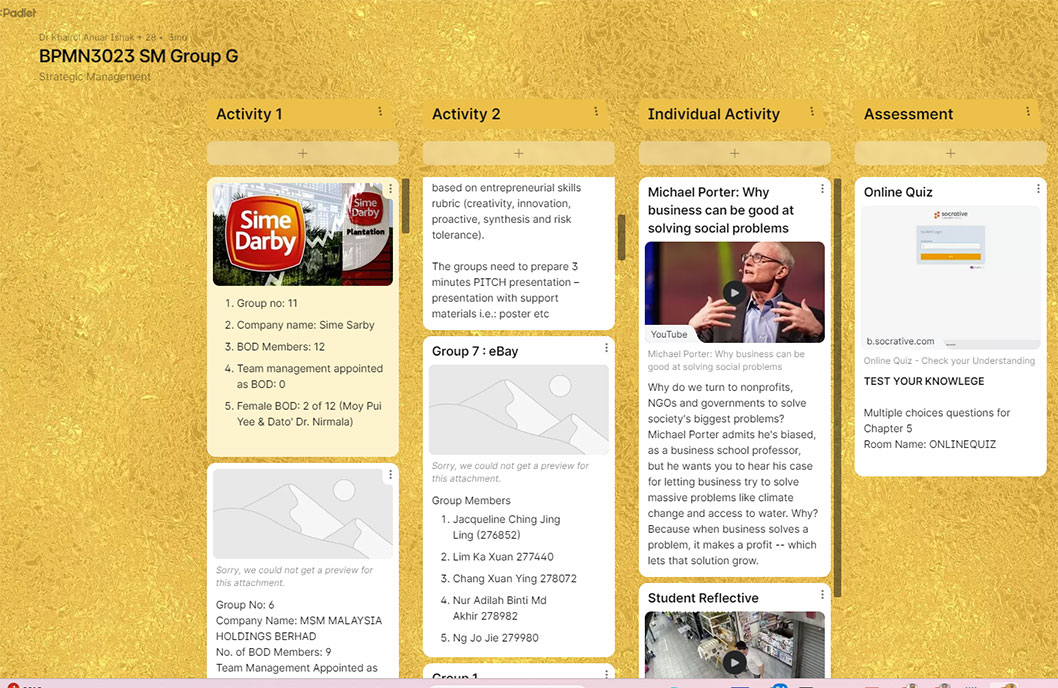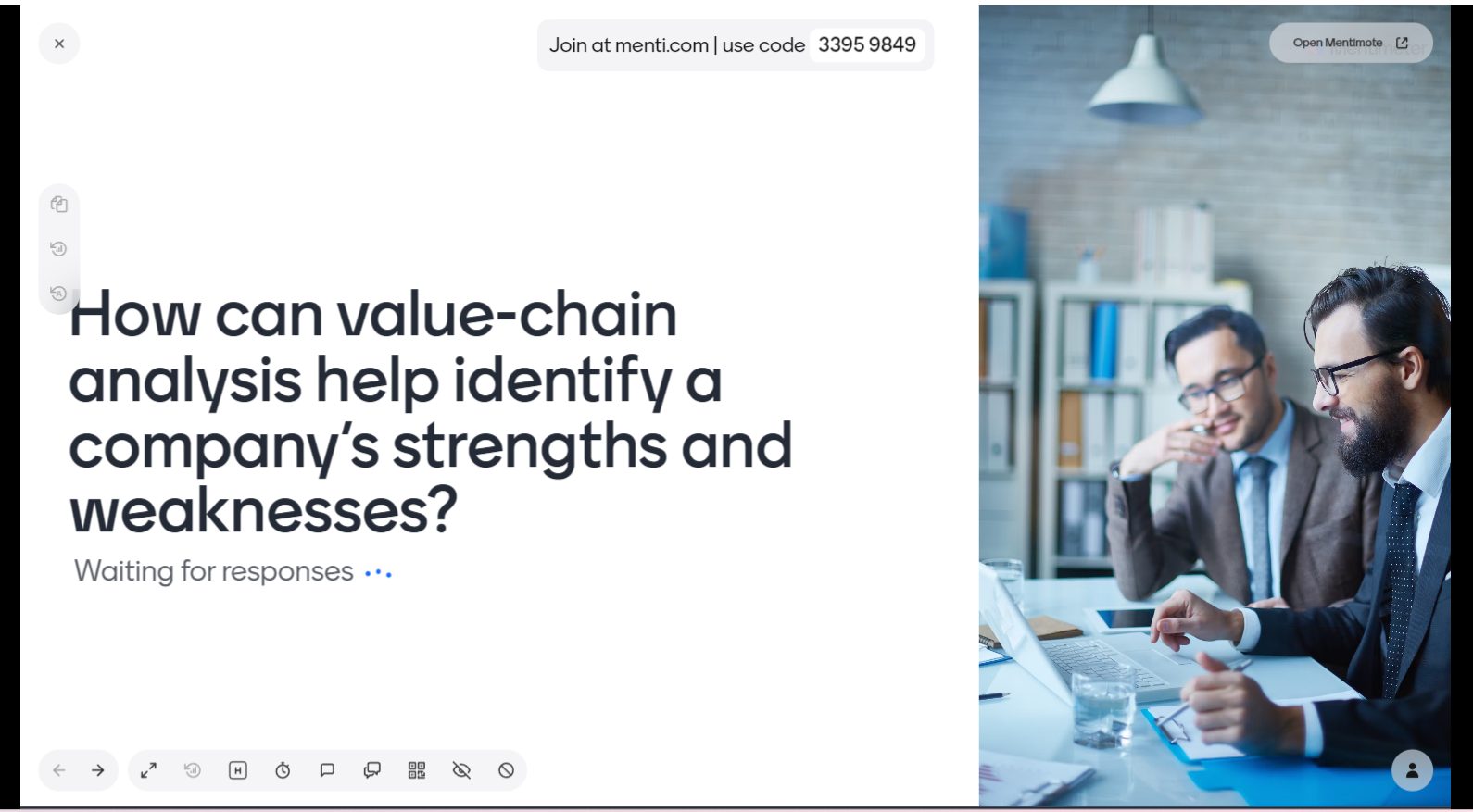Strategic management provides the basis for adapting the organisation to the vagaries of an unpredictable, turbulent environment and for more effectively and efficiently achieving the firm's objectives
Strategic management provides the basis for adapting the organisation to the vagaries of an unpredictable, turbulent environment and for more effectively and efficiently achieving the firm's objectives. Strategic Management is the continuous process of analysis, planning, and action to keep a firm is aligned with its external environment. It aims to capitalize on organisational strengths and environmental opportunities while minimizing or avoiding organisational weaknesses and environmental threats. Strategic management is a multidisciplinary course that integrates the knowledge learned from other courses that were concerned with a specific functional area (e.g. production, marketing, finance, accounting, human resources), and/or well-defined and specialised body of knowledge (e.g. economics, statistics, business law, information systems). In contrast, the problems and issues of strategic management cover the whole spectrum of business and management.
Overall Teaching and Learning Philosophy
Consistent with the Malaysian Higher Education Philosophy and National Higher Education Development Plan 2015 – 2025 which emphasized on balancing and harmonizing education in intellectual, spiritual, emotional and physical based on faith and submission to God.
I believe that everyone has a role to play to create a better world. As each students have their own unique capabilities and talents that they can contribute to society, it is my privilege to inspire them with ideas, guidance and stimulating environment where students will develop confidence and at the same time being humble and respectable to others, enjoy learning experience, and show their commitment, responsibilites and care towards other human beings. As such, I always encourage my students to speak up their minds, to be themselves, to be brave to try new things, not afraid of making mistakes and learning from it, as I am also in the process of learning in this big classroom of of life.

Through my experiences as a student, teaching assistant, course director and informal instructor in the disciplines of environmental education, outdoor education and environmental studies, I have had the opportunity to reflect on my approaches to teaching and learning. Here, I share what I believe to be the underlying theoretical and philosophic approaches I bring to and apply in the classroom as part of a teaching team.
I believe that there is more than one way to learn. I act on this belief by focusing my classes around Kolb’s experiential learning cycle and through paying attention to students’ different approaches to learning. The courses I teach are focused on providing authentic, concrete experiences. Taking a course-long perspective to experiential learning, I see assignments in relation to each other; each developing skills that are further reinforced by the next task.
1. Reflection on your overall strategy in teaching/supervision as well as evaluation.
Effective teaching, supervision, and evaluation are essential components of successful class management. Here's a comprehensive strategy that encompasses all aspects:
- Clear Expectations and Objectives: Clearly communicate the learning objectives, expectations, and grading criteria at the beginning of the course. This helps set a framework for students and provides them with a roadmap for success.
- Engaging Instructional Strategies: Use a variety of instructional strategies to cater to different learning styles and keep students engaged. Incorporate activities such as group discussions, hands-on projects, multimedia presentations, and real-world applications of concepts.
- Positive Classroom Environment: Foster a positive and inclusive classroom environment where all students feel valued and respected. Encourage open communication, active listening, and constructive feedback among students and between students and the teacher.
- Differentiated Instruction: Differentiate instruction to meet the diverse needs of students. Provide additional support and resources for struggling learners while offering enrichment opportunities for advanced students.
- Effective Supervision: Regularly monitor student progress through formative assessments, class participation, and individualized feedback. Address any issues or concerns promptly and provide additional support as needed.
- Collaborative Learning: Promote collaborative learning experiences where students work together in groups to solve problems, discuss ideas, and share perspectives. Encourage peer teaching and peer evaluation to enhance understanding and communication skills.
- Technology Integration: Integrate technology tools and resources to enhance teaching, learning, and assessment. Use online platforms for assignments, discussions, quizzes, and feedback to facilitate communication and streamline the evaluation process.

2. Please reflect on your creativity and innovation as well as its impact on teaching and learning
Creativity and innovation in teaching and learning can help students develop problem-solving skills, improve thinking, and learn through fun. Creative teaching can also help students become more engaged and motivated, and can lead to better academic achievement. Innovation in education isn’t a specific term with fixed definitions. The spirit of innovation education is an openness to looking with fresh eyes at problems and to address them in different, new ways. It is a recognition that we don’t have all the answers and are open to new approaches to improve such as methods of knowledge transfer with innovative teaching strategies. Innovation in education comes from identifying problems, watching and learning from others, to develop new methods to address these problems, and iterating on them when these experiments don’t necessarily give the results you need. there are an examples of my teaching innovation for teaching this subjects:
- Blended Learning – Blending learning combines online learning with traditional classroom learning. Students must become comfortable with online tools and using the internet to contribute to their learning. A blended learning approach gives students the ability to discover how best to use tools that they will rely heavily on in their professional lives.
- EdTech – Educational technology (edtech) typically refers to any software, application or service developed to enhance education. We must be careful not to go too far into the deep-end but introducing technology in the classroom is important. Innovative classroom technologies often mirror the innovations outside of education. So, the more students engage with technologies in the classroom, the better prepared they will be to engage with and through technology in the workplace.



MAIN TEXT
Hitt, M.A., Ireland, R.D. and Hoskisson, R.E. (2020). Strategic Management: Competitiveness & Globalization: Concepts and Cases (13th Ed.). Singapore:Cengage Learning Asia Pte Ltd.
REFERENCES
Dess, G.G., McNamara, G., Eisner, A.B. & Lee, Seung-Hyun (2021). Strategic Management: Text and Cases (10th ed.). New York: McGraw-Hill.
David, F. R. & David, F.R. (2017). Strategic Management: A Competitive Advantage Approach, Concepts and Cases (16th ed.). New York: Pearson.
Gamble, John, Thompson, Arthur A., & Peteraf, Margaret A (2014). Essentials of Strategic Management: The Quest for Competitive Advantage. (4th ed.). New York: McGraw-Hill.
Haim, H. A. (2011). Pengurusan Strategik (2nd ed.). Kuala Lumpur: McGraw-Hill.
Hashim, Mohd Khairuddin (2008). Strategic Management (2nd ed.). Kuala Lumpur: Thomson Learning.
Hitt, M.A., Ireland, R.D., & Hoskisson, R.E. (2017). Strategic Management: Competitiveness & Globalization: Concepts and Cases (12th ed.). Singapore: Cengage Learning.
Jones, Gareth R., & Hill, Charles W.L. (2013). Theory of Strategic Management (10th ed.). Stamford: South-Western, Cengage Learning.
Rothaermel, Frank T. (2021). Strategic Management (4rd ed.). New York: McGraw-Hill
Thompson, Arthur A., Peteraf, Margaret A., Gamble, John E., & Strickland, A.J. (2012). Crafting and Executing Strategy: Concepts and Cases. (18th ed.). New York: McGraw-Hill.
Wheelen, T., Hunger, J., Hoffman, A. & Bamford, C. (2018). Strategic Management and Business Policy: Globalization, Innovation and Sustainability. (15th ed.). New York: Pearson.













